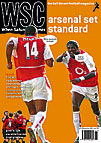 As Roy Keane reflects on an eventful career, Joyce Woolridge questions the representation of United's skipper and the influence of the ghost writer
As Roy Keane reflects on an eventful career, Joyce Woolridge questions the representation of United's skipper and the influence of the ghost writer
“Journalists and players have an uneasy relationship… Journalists tend to try and make the player say the things they want him to say. And it is all too easy for them to do this… This shows particularly when they are on the ‘discontented player’ story.”
Eamon Dunphy, Only A Game?
A ghost stalks the pages of Roy Keane’s autobiography: the unquiet spirit of professional Irish malcontent, Eamon Dunphy. The ghostwriter who transcribes the tapes and knocks the pieces into shape usually leaves some sort of footprint on the text of a footballer’s life, whether a flowery metaphor or a stock phrase.
But readers who have more than a passing acquaintance with Dunphy’s own groundbreaking football autobiography of 1976, Only A Game? will recognise immediately that Keane’s Boswell has left far deeper marks. The version of Roy Keane which inhabits this book is another incarnation of the “good pro” to whom Dunphy dedicated his own work. He is what Dunphy himself might have been given another shot in football, revisiting the game as a more talented player who had made it at Old Trafford, rather than being discarded for the lower divisions, a central figure in the Ireland team rather than a bit player.
This is not to say Keane is Dunphy’s mouthpiece, but that writer and subject have found each other. Their preoccupations, platforms and pessimism have become almost a seamless whole. And it may be that the process of writing this book itself contributed to the events that led to Keane’s premature exit from the World Cup. Rehearsing his thoughts on the shambolic Irish setup (by far the most entertaining and contentious sections of the book) to such an encouraging audience as Dunphy may have made it that bit harder for Keane to stomach what he perceived as the inexcusable amateurism of the Irish preparations (potholed pitches and cheese sandwiches) and the limitations of the team’s manager.
As befits the good pro, Keane is supposed to emerge from these pages as an honest and uncompromising figure. But there are always inherent contradictions where Roy just does not fit the template. A relatively late entrant to the professional ranks, having missed the usual schoolboy route because he was judged to be too small, Keane claims, even from the start, to have valued his job far more than the dressing room whingers who were never content. But then he admits that he wasted much of his potential as a younger player by drinking heavily on binges in Cork and Altrincham, and himself whinges at length about his complacent team-mates (“bluffers and bullshitters”), about Irish international football past and present, and about the fact that he never played in the Champions League final.
However, there is a sense that the “real” Roy Keane is here, the “driven bastard” who is never satisfied and who admits that his greatest failure is his inability to control himself. The book explains Roy’s problems with a bit of amateur psychology as the result of a “split personality”, the two sides of his character presumably illustrated by the twin black-and-white close-ups which form the jacket. On the front Roy is unsmiling and looks scary; on the back, he grins wolfishly and looks even scarier.
The rational Roy Keane knows he should not tell the mouthy punter who demands an autograph where to go; should not tell Mick McCarthy up where to stick his World Cup (arse rather than bollocks in this more anatomically plausible, but less inventive version). The professional Roy understands he should turn the other cheek on the pitch, the “other” Roy, still with the survival instincts of the smallest boy in the class, cannot do it. Revealingly, his favourite comic character is Basil Fawlty, a figure not known for holding back.
As for the Haaland “vendetta”, the admission that he hurt the Manchester City player in retaliation for claiming he was feigning injury when his cruciate ligament had snapped has indeed brought Keane up before the FA on a disrepute charge. But despite claims to the contrary, such revelations are nothing new in football biographies. A quick trawl through the life stories of some of football’s more notorious “hard men” will unearth plenty of tales about how they waited to “do” fellow professionals and were “done” in return, and how the game was much better for it.
Ultimately, Keane’s gritty and often compelling book may turn out to be a watershed, if not for all other footballers, at least for future Manchester United players and managers. There will doubtless now be a clause in their contracts which obliges them to put their names to books which are published in-house and picked over by the club’s lawyers, for which the rewards will be far less than the advance reportedly pocketed by our Irish anti-hero.
But United fans, with yet another season ushered in by an autobiography-generated furore which has a deleterious effect on the pitch, may be the only ones who will welcome the return of the bland, anecdote-stuffed life, filled with “great times” and populated by “great lads”, fit only for serialisation in Bunty.
From WSC 189 November 2002. What was happening this month